Blog
Paradise Lost – The Good Ship S.S. Sagalnaam
“Whether you are struggling to hold on to your free space on the deck to get some sleep, taking your chances with the restaurant on board, or daring to enter the toilets in the final few hours of the journey, you will remember these moments for a long time.” – Shanny Hill
Progress always comes at a price. Whether that price is worth it or not is the question.

When the inaugural Tour d’Afrique took place in 2003 there was only one way to go overland from Egypt to the Sudan, over the waters of Lake Nasser. The first cyclists rode on a barge towed by a tug boat from Abu Simbel in Egypt to Wadi Halfa in the Sudan. 2003 cyclist Paul Davison remembers the experience, “I recall the tug broke down after we had barely covered 5 km, and it required the concerted efforts of African Routes staff Rory and Eddie to fix the engine and get it running again. During that time, the riders had a superb view of the relocated Abu Simbel temples across the water, tempered with concerns about how long we would be drifting aimlessly on the world’s largest hydro reservoir (at the time). There was just us, the bikes and one African Routes truck on the barge, and as the day progressed it got hot. Some sought shade by crawling under the truck…We arrived in Wadi Halfa just as the sun was setting and the experience of stepping onto Sudan soil was unreal. Nothing says you’ve arrived in Africa like this.“
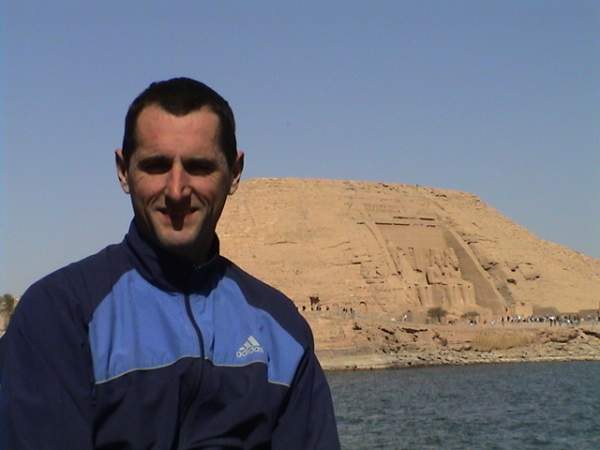
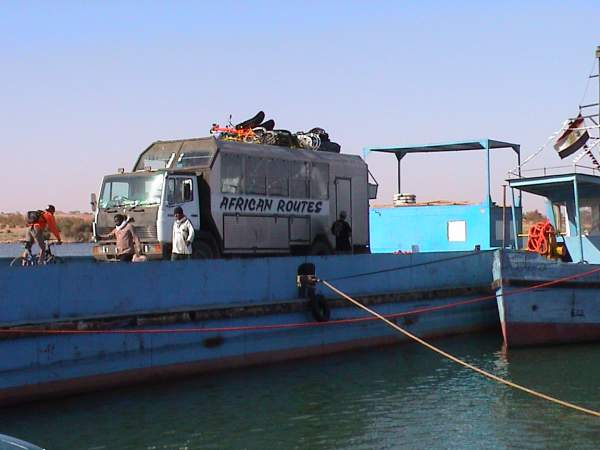

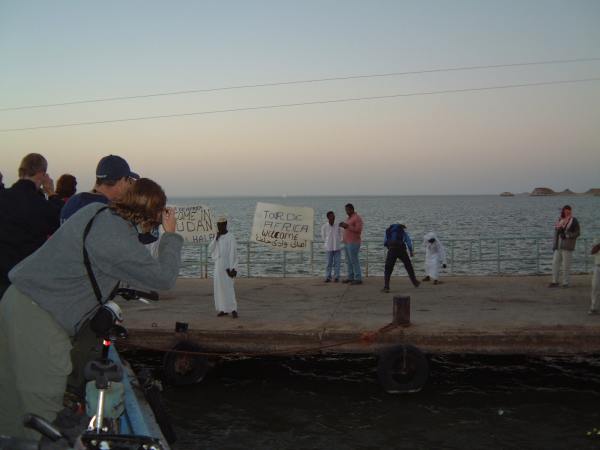
However, as Founder Henry Gold tells it, “In 2005 we went back to Abu Simbel and the small ferry that was supposed to take us to Sudan. Then, in the middle of the night, Randy (Tour Leader) was woken up and told that we all had to go back to Aswan and board the ferry in Aswan and not in Abu Simbel due to security reasons. There was nothing we could say that they would listen to. So we had no choice but to rent a bus, send our little convoy off to Aswan and then do it that way. It delayed the tour by 3 or 4 days which had to be made up along the way. It was all crazy, so we decided next year not to take the chance.”
As a result, beginning in 2006, Tour d’Afrique riders no longer took the barge at Abu Simbel but instead clambered aboard the S.S. Sagalnaam (Trans: Ostrich Leg) in Aswan. This city is the the site of the High Dam that holds back the Nile River. Built in the 1960’s, it created Lake Nasser and allowed the Egyptian authorities to better control the flow of the river and thus the country’s agricultural production.

This ancient German made vessel, operated by the Nile Valley River Transportation Corporation, would likely never pass any serious inspection. The official capacity was given as 600 passengers but, as any Tour d’Afrique participant could tell you, ‘really, who’s counting?’ One previous traveller commented that “This is not a luxury ferry and conditions on board tend to be unhygienic if not downright unsafe.”
The journey to Wadi Halfa takes about 18 hours but that doesn’t include the boarding in Aswan. Riders had to arrive early in the morning to check-in and make their way through customs and passport control. Then it was a matter of struggling through the masses of other passengers to make their way onboard and maneuver their bikes up the crowded stairwells to the upper deck.
Once there they could find a comfortable spot on the deck or in one of the ‘first class’ cabins. 2010 cyclist Sunil Shah felt lucky to have access to one of the latter until a fellow cyclist wandered in. “He walked over to the bed and lifted up the corner of the mattress to point out roaches. So many roaches. They were happy enough crawling around in their dark and warm home under the mattress and didn’t appear to be venturing out ‘above mattress’ too often.” Another 2006 rider, Corey Heitz, commented that, “The windows were welded shut and the toilet soon overflowed.”
Still, the rest of the day could be spent pleasantly watching the incredible process of loading all the baggage that was brought on board – endless boxes of Twinkies, refrigerators and God knows what else – carried onto the ship in a continual procession of porters until virtually every nook and cranny was filled to overflowing. Finally, just as the sun was fading in the west, the S.S. Sagalnaam would pull away from the dock and head south.

Once out on the water, the riders could take the opportunity to wander through the ship, perhaps even taking a chance on a meal in the ship’s restaurant. Most of the other passengers would be small-time traders who would construct walls of sacks of herbs and spices, henna and dates on the decks and in the stairwells. Soon they would be playing cards and chatting with each other, comfortably settling for the night. The waters are calm, the sunset is stunning and once the stars come out, the overhead view is nothing short of spectacular. Now, this is slow travel at it’s best!
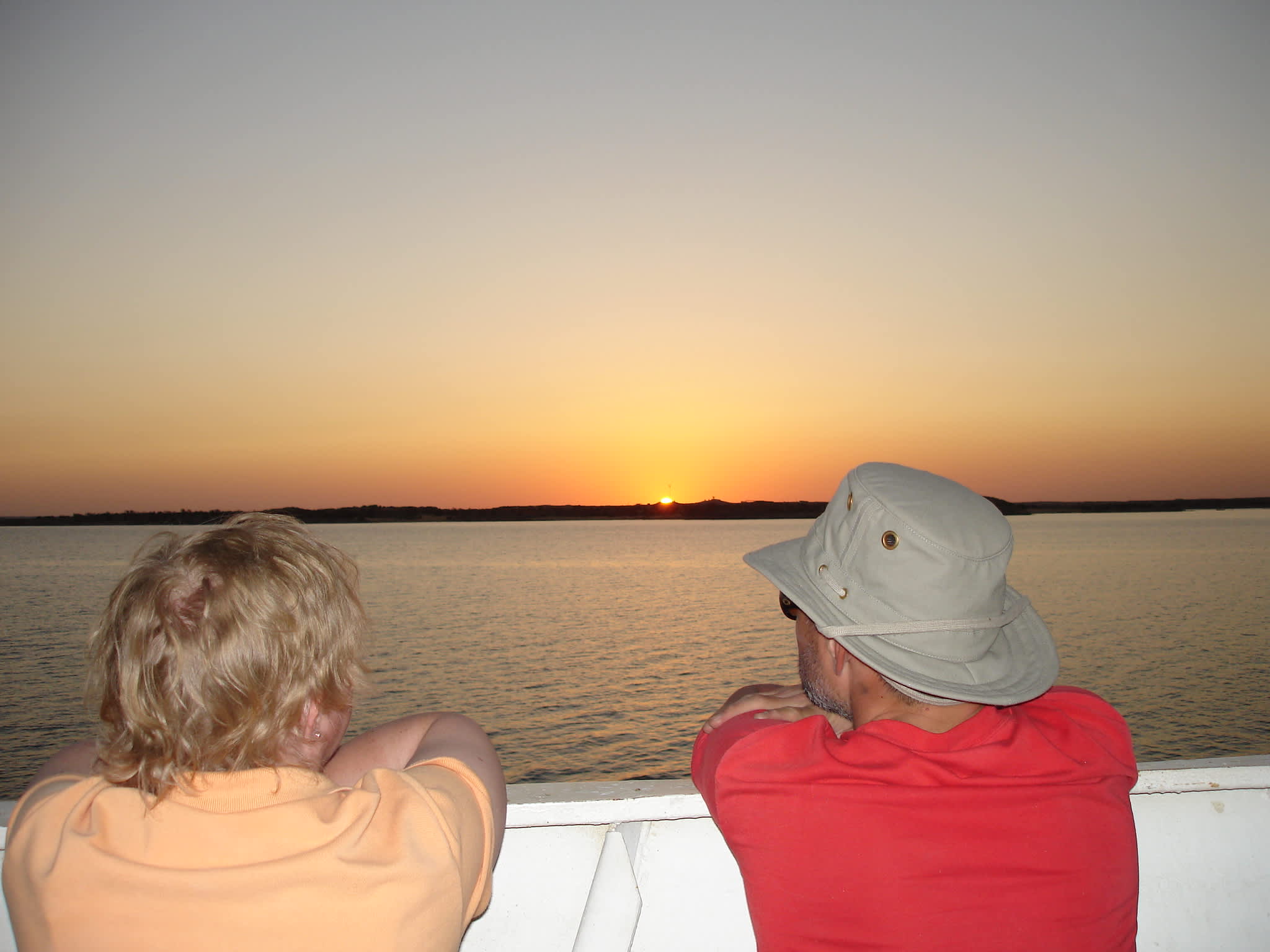
Sunset on Lake Nasser
 Of course, this is Africa (TIA) and so the riders would have to deal with the constant squawking of the ship’s loudspeaker, demanding passengers report to the office for passport screening and, more importantly, health checks. As 2010 rider Sunil Shah fondly remembers, “Eventually, I reached the room, while the previous rider was still in there. An official looking doctor (wearing a dirty white coat) shoved a thermometer in my ear and signed a form. Immediately afterwards, the same thermometer was used for the following rider and was no doubt used for every patient without being cleaned. If we weren’t ill before the medical examination, we were almost certain to become ill after it!”
Of course, this is Africa (TIA) and so the riders would have to deal with the constant squawking of the ship’s loudspeaker, demanding passengers report to the office for passport screening and, more importantly, health checks. As 2010 rider Sunil Shah fondly remembers, “Eventually, I reached the room, while the previous rider was still in there. An official looking doctor (wearing a dirty white coat) shoved a thermometer in my ear and signed a form. Immediately afterwards, the same thermometer was used for the following rider and was no doubt used for every patient without being cleaned. If we weren’t ill before the medical examination, we were almost certain to become ill after it!”
Finally, around midnight, the ship’s communications system goes quiet and the boat silently slips through the night…until the 04:30 call to prayer! Conveniently, this serves as a reminder that it is time to get up so as not to miss the incredible sight of the massive rock-cut temples at Abu Simbel at dawn. These were built by the Pharaoh Ramesses II in the 13th century BC and relocated in 1968 to avoid being submerged by the waters of Lake Nasser.
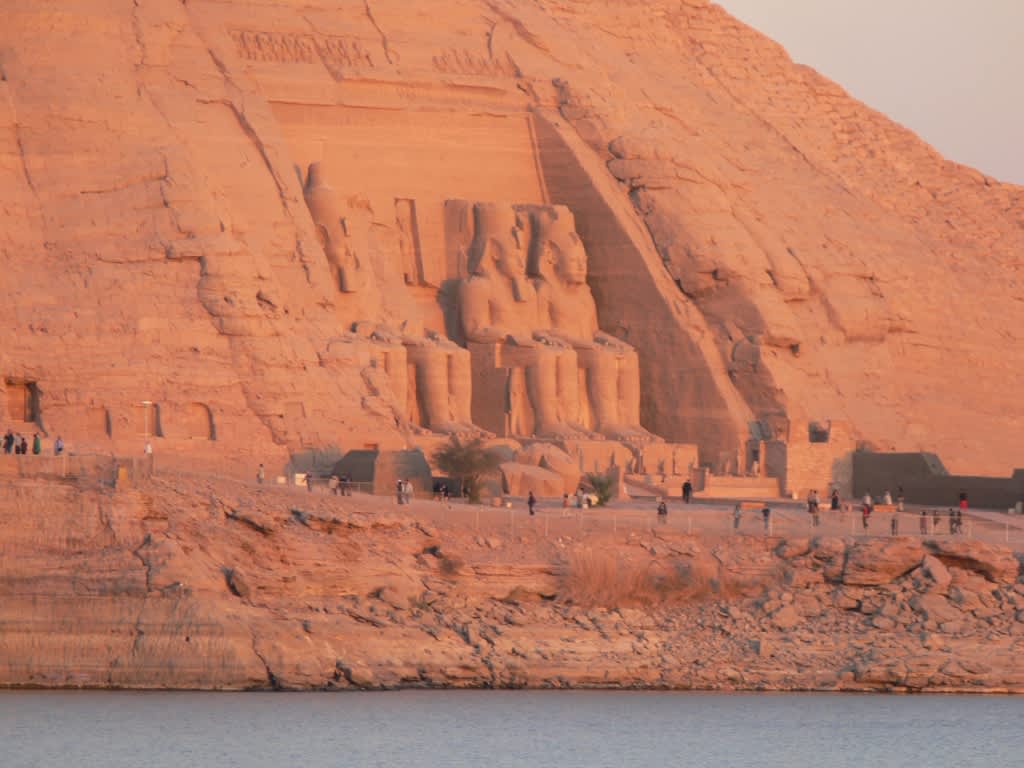
Abu Simbel
A few hours later, with what a TDA staffer remembers as, “A lower deck which smelt of last night’s dinner, a toilet in need of attention mixed with a hint of gasoline, and an upper deck which resembled more of a department store rubbish pile turned hide-and -go-seek-nap-time,” the Sudanese town of Wadi Halfa appears. Known to 19th century troops, on one of their frequent marches from Egypt to the Sudan to put down a Nubian rebellion, as ‘Bloody Halfway’, the riders’ arrival here marked the end of their unforgettable ride across Lake Nasser on the venerable S. S. Sagalnaam. As our Marketing Manager, Shanny Hill, commented in 2013 as he contemplated the possibility that a land crossing would soon be in operation, “If this was indeed our final crossing, I hope that for all of this year’s riders it was no less eventful. Cherish those memories!”
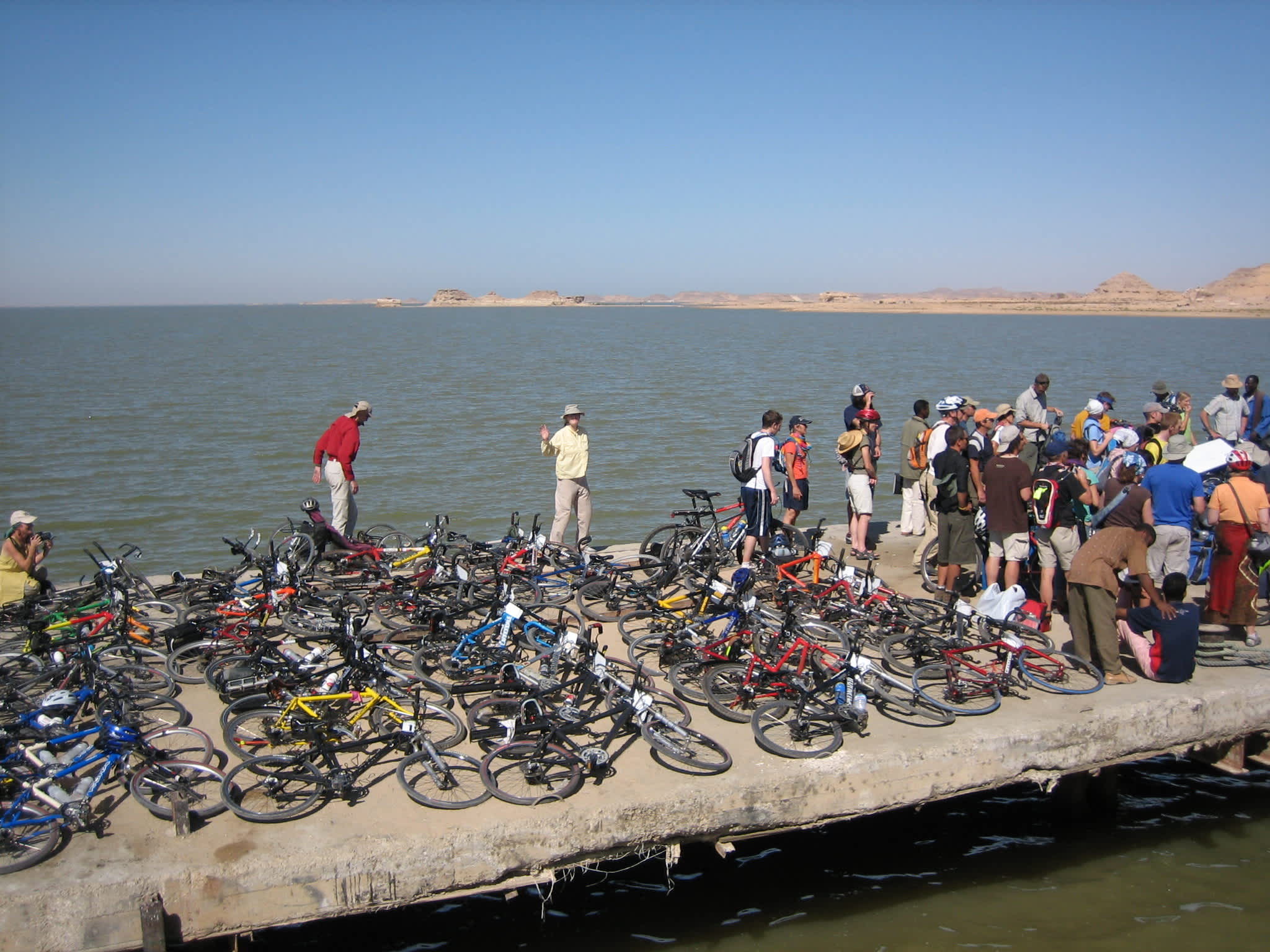
Arrival in Wadi Halfa
Since 2015 (in 2014 the Tour d’Afrique started in Khartoum), the participants on the Tour d’Afrique have missed out on this fascinating ride across Lake Nasser. The opening of the land border between Egypt and the Sudan means that the route now stops for a rest day in Abu Simbel in order to explore that amazing UNESCO World Heritage site. The next day, the cyclists take a 60 minute ferry across the Nile at the northern end of Lake Nasser to the eastern side and then cycle about 40 km to the Egypt/Sudan border. Then they cycle another 40 km to Wadi Halfa. It is quite a marvellous experience and one that few people in the world will have the opportunity to enjoy but to those of us who sailed across Lake Nasser from 2006 – 2013, perhaps in this case, the price of progress seems a little steep.
“They paved paradise, put up a parking lot…Don’t it always seem to go, That you don’t know what you’ve got till it’s gone.” – Joni Mitchell
 REGISTER NOW
REGISTER NOW



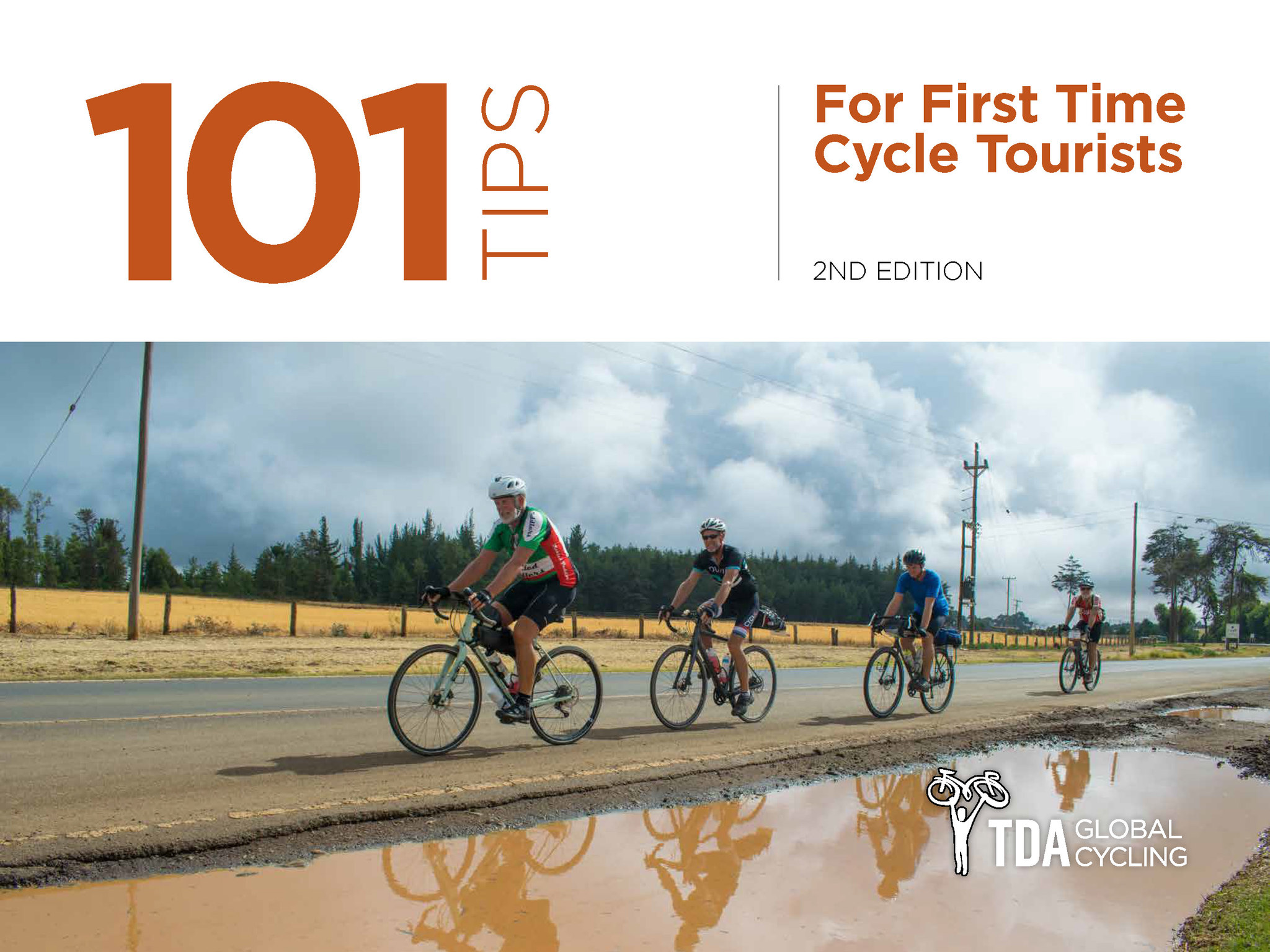
Leave a Comment for "Paradise Lost – The Good Ship S.S. Sagalnaam"